Managing Disc Herniation and Alleviating Sciatica: Tips and Tricks 1
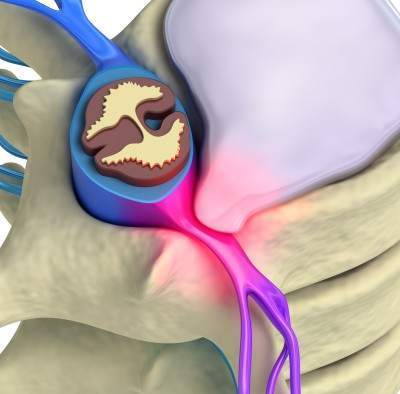
Suffering from disc herniation? Experiencing sharp pains shooting through your buttock, thigh, and leg due to sciatica? If your daily routine is disrupted by the discomfort of disc herniation, there’s hope. Many people find relief without needing surgery. This post will guide you through lifestyle changes to support your recovery from disc herniation. Stay tuned for our next piece, where we’ll explore exercises to correct and stabilize your condition.
Ultimate Guide To Exercises For Lumbar Disc Herniation Relief
Mary’s Story: A Wake-Up Call
Imagine starting your day like any other, performing your routine toe touches, when suddenly you’re hit with an excruciating pain radiating from your lower back down to your toes. This was Mary’s reality when she encountered a lumbar disc herniation, commonly referred to as a slipped or ruptured disc. Such incidents can lead to what’s known as sciatica or radiculopathy, terms doctors use to describe the pain that extends down your leg.
Understanding Lumbar Disc Herniation:
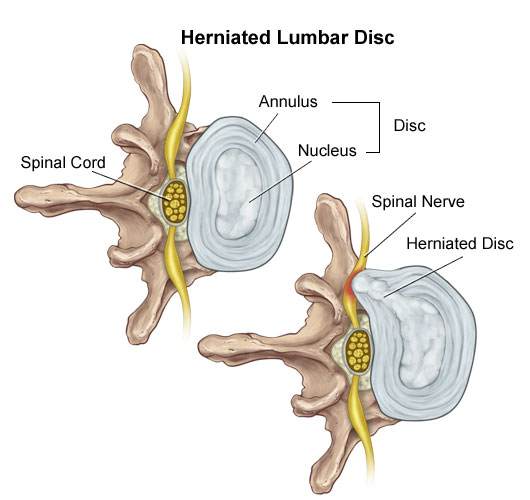
A glimpse into the anatomy of a herniated disc reveals two main components: the tough outer annulus and the softer, inner nucleus. Dr. Stuart McGill likens the nucleus to sticky phlegm. When Mary bent forward, it was akin to squeezing the front of a jelly doughnut, pushing the inner material backwards and eventually causing the disc to bulge and press on a nerve.
The Culprit Behind the Pain:
Mary’s disc herniation wasn’t a sudden mishap but the result of years of repetitive motions like toe touching and prolonged slouching at her desk. These habits gradually weakened her disc, leading to the moment when it finally herniated and impacted her nerve. The lack of nerves within the disc itself means significant damage can occur without immediate pain, explaining why the problem might not be felt until it’s severe.
A Lesson Learned:
The story underscores the importance of posture and the dangers of neglecting spinal health. While the advice to “sit up straight” might seem simplistic, maintaining the natural curve of your back is crucial. Mary’s experience serves as a potent reminder of the long-term consequences of poor posture.
Disc herniations don’t have to dictate your life. By understanding the causes and adopting preventive measures, you can manage and alleviate your symptoms.
Understanding Disc Herniation: Pain, Prevention, and Care
The Unseen Progression of Disc Herniation (see picture above)
- Bulging Disc: Early stages where the disc starts to protrude due to wear and tear.
- Prolapsed Disc: The disc bulges more as it degenerates, but the nucleus remains contained.
- Extruded Disc: The protective layers give way, pressing on nerves and causing pain.
- Sequestrated Disc: The most severe stage, where disc fragments break away, potentially compressing nerves or the spinal cord.
See Also: MRI, CT scan and X-rays: Is an MRI, CT Scan or X-ray Best For My Pain?
Why Me? The Role of Movement and Genetics in Disc Herniations
Surprisingly, your daily habits and genetic makeup play pivotal roles in disc health. While we can’t choose our genetics, modifying daily movements can significantly reduce the risk of herniation. Proper lifting techniques and posture adjustments are crucial first steps.
Simple Changes, Major Impacts: Daily Habits and Exercise
To protect your spine:
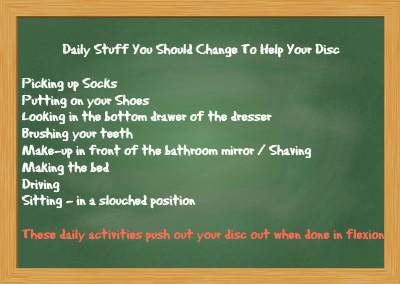
- Adjust Daily Habits: Learn to perform everyday activities in spine-friendly ways to prevent further disc damage.
- Disc-Specific Exercises: Exercises can help reposition the herniated disc.
- Stabilization Routines: Strengthening your core helps maintain spinal integrity, preventing future herniations.
Lifting Techniques: How Weight Lifters Should Lift
Master the Basic Butt-Lifting Technique for Disc Health
- Practice with a long, straight object to ensure your back remains aligned.
- Ensure it touches your butt, mid-back, and the back of your head during the entire motion.
- Squat down and maintain contact with 3 areas and keep the lower back arched the whole time.
- Aim for 30 repetitions to embed this healthy habit into your daily routine for 10 days
Daily Activity Guide: Protecting Your Discs
Then you integrate this lifting technique into everyday life. Initially, whenever you do any of these activities, use the same basic move and you will stop pushing out your disc.
In the beginning, you will need to be conscious each time you are doing any of these activities. To speed things up you can practice each activity like picking up your socks 30 times using the butt lifting technique and it will become even more automatic. You can deepen muscle memory during all of these activities.
For sitting in a chair and driving I recommend that you roll up a Mckenzie Lumbar support roll and put that in the arch of your lower back
Guide for disc herniation daily activities.
- Remember to do all these movements pain-free. Always stop whenever you run into pain with any movement of the spine.
- Disc herniations are linked with long periods of sitting, especially prolonged driving.
- Disc herniations are caused by repeated flexion.
- Prolonged trunk flexion or twisted or bend sideways cause disc herniations.
- Too much lifting, pushing/pulling causes disc herniations
- Vibration while sitting is linked to disc herniations.
- After prolonged stooping or sitting, you should stand. For example, a gardener lifting bags of peat moss after having a prolonged period of rounded lower back, or a driver getting heavy loads out of the trunk after a long drive is not recommended. You should remember to stand for a few minutes before attempting to lift. Studies have shown that ½ hour is even better.
Here are some more exercises that can cause disc herniation.
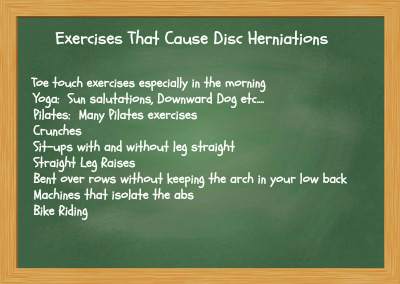
Activities That Put Out Lumbar Disc Herniations
Yes, it’s very surprising that toe touches, Yoga and certain Pilates can cause disc pressure leading to disc herniations. I have personally treated dozens of Yoga teachers with varying degrees of experience. The fact is some of the exercises involved in Yoga are great for helping disc herniations while others directly push the disc out.
Many Yoga Exercises Put Out Disc Herniations
I know many Yogis who have had to stop many of their exercises due to the pain it cause them in various parts of the body, including their disc.
Next week’s article will go over the second and third ways to help your disc. Remember, you need to do #1 “Daily Disc Activities Correctly” first so that your disc doesn’t keep getting aggravated. Then you can move on to next week’s article which goes over #2 Disc Exercises to Push the Disc Back In and #3 Stabilization Exercises help by keeping the disc from coming out by normalizing how your spine moves.
Looking Ahead: Comprehensive Care for Disc Health
Next week, we delve deeper into specific exercises for disc realignment and stabilization techniques, in this article called Ultimate Guide To Exercises For Lumbar Disc Herniation Relief. Remember, starting with correct daily activities is essential to prevent aggravating your condition further.
Tell us what you think in the comments below and like us on Facebook. This Toronto Downtown Chiropractor will answer all questions in the comments section.
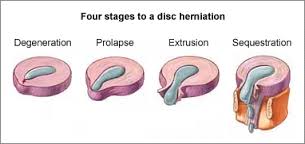
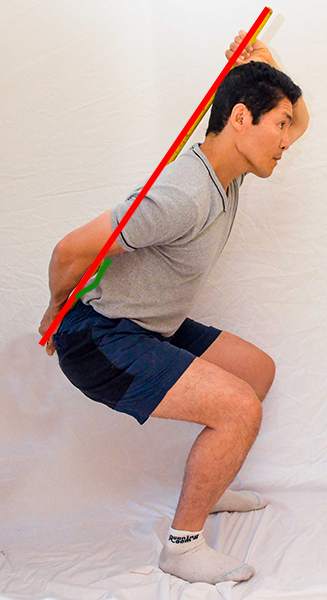


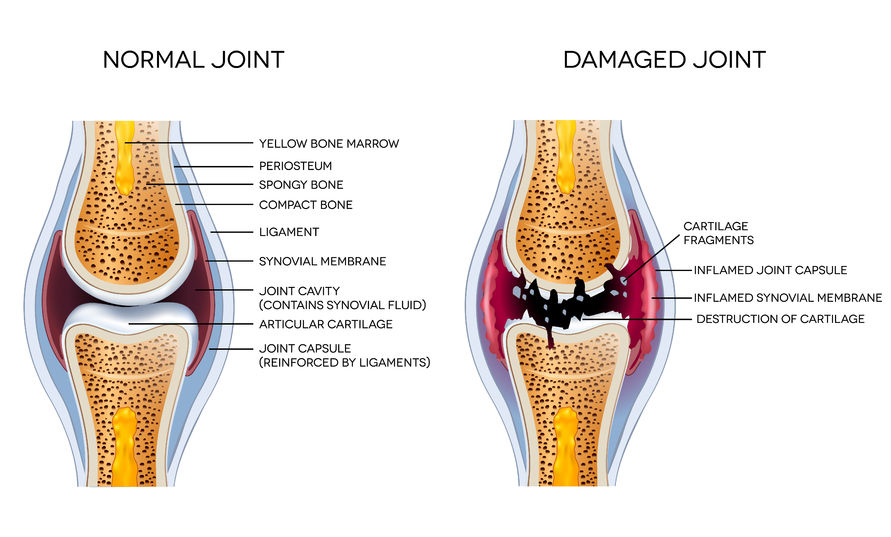
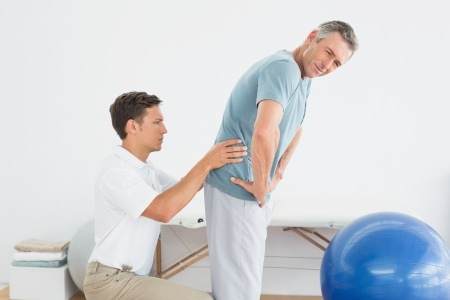
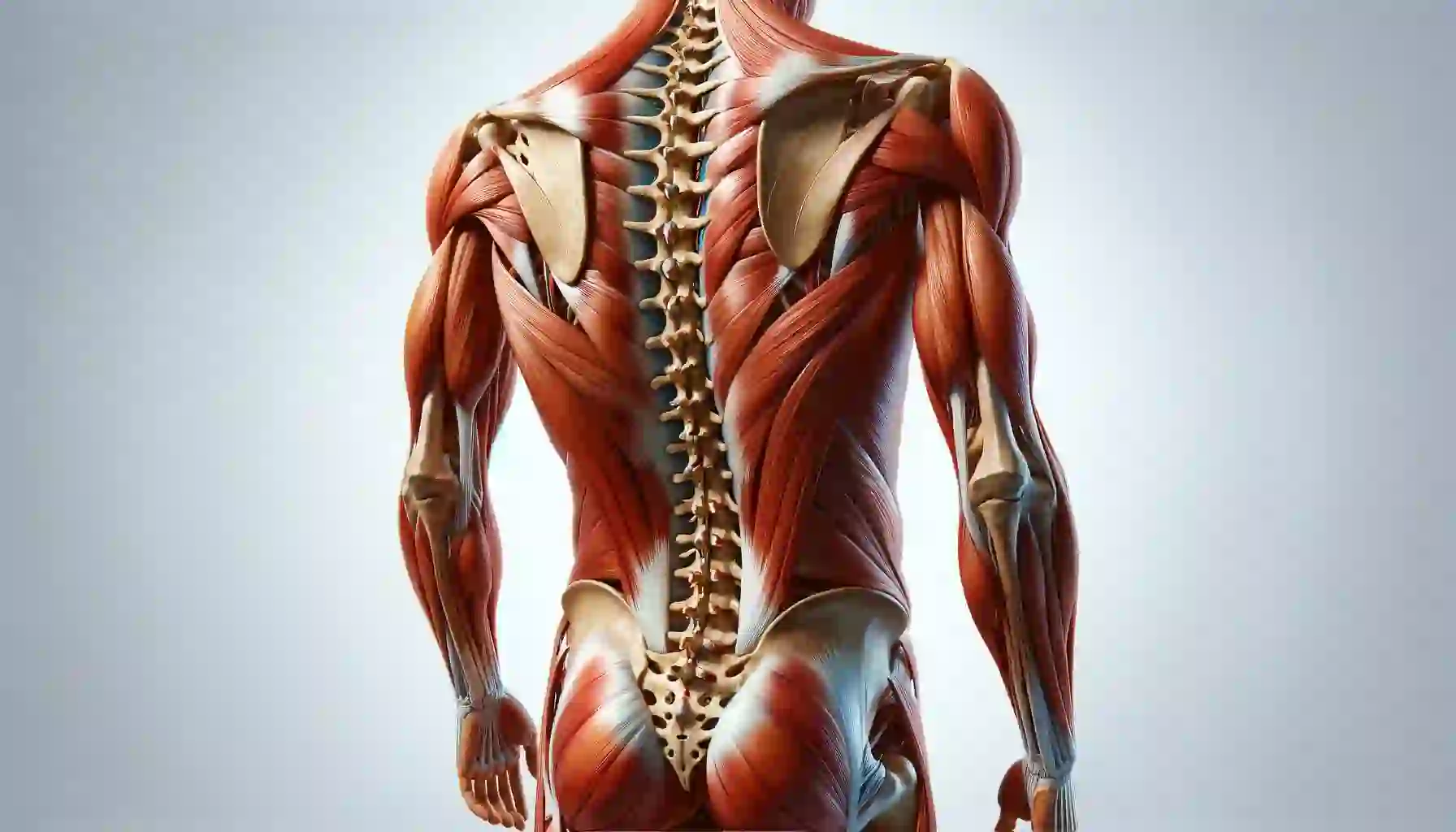
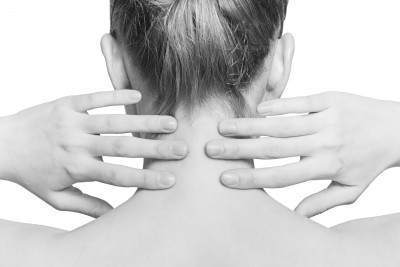
Hi Dr Ken,
First, I like to thank you for such an informative website with really nice illustrations that is easy to understand on what is going on in the spine. Please keep up the fantastic work. I have a quick question and put in point form for ease of reading.
Injury & Treatment:
Minor bulging to prolapse disc on L5/S1 during weight training. Painful for about 5 days and progressively better following on from physiotherapy, static stretching and strengthening exercises.
Questions:
1) Would the cells and tissue in the annulus regenerate overtime to prevent spillage of the nucleus?
2) Your article mentioned bike riding is also high risk for disc herniation. As an enthusiast cyclist, what should I be particularly conscious of when I get back on the bike after this injury.
3) Do I need to adjust the saddle tilt to accommodate the past injury or let it be and let the body slowly adapt back to the pre injury condition.
Many thanks in advance.
Jay
Author
Thanks for your question Jay.
1. No the annulus does not regenerate it usually only degenerates starting at age 7-8. Yes 7 or 8 is when the blood vessels feeding the disc starts to disappear, by the tme you are 20 years of age they have disappeared. Since the disc now has to absorb everything by diffusion things aren’t as efficient as blood vessels so the disc cells start to die.
2. You should bike with an arch in your back. Arrow position will certainly make you worse.
3. Getting higher handle bars so you aren’t in a flexed position is more helpful but a slight tilt forward of the saddle may be helpful.
Hope that helps your disc herniation.
Sir
I had my MRI done few days back and Orthopedic advised 21 days complete bed rest while my nephew who is a PT insists on starting excercises for speedy and better recovery
Findings of MRI
Posterior and right paracentral herniation of L4-L5 intervertebral disc is causing compression over right ventral theca and right side descending nerve roots
AP diameter at L4-L5 is 10.4 MM while is 12 mm in L3-L4 and 11.2 mm in L5-S1
I have pain in right leg below the knee while walking
please advise course of action and doctor has advised belt for 3 months when walking
regards
Sudhir
Author
Thanks for your question Sudhir. I cannot advise you on this as you professional care with a health provider that can examine you and take a proper history.
Hope you understand your disc herniation requires more hands on attention.
Hello Dr
My case is of sequestration in L5 and S1 and problem in L4 – L5 as well. However my concern is that can sequestration be recovered just by resting or shall I do something else as well. I mean what shall I do as currently I am unable to sit, stand or lie down properly. It is very painful and I fail to understand what to do? If you want I can mail you my mri report.
Author
Thanks for your question Ashish. If you have the following then you are a candidate for surgery.
1. Worsening neurological symptoms like drop foot. ie when you lift your leg up your foot drops down. It would be very obvious to most people.
2. Bowel or bladder symptoms like you can’t urinate or have severe constipation
If you have tried 6 months of therapy with several different health care providers with no avail.
The good news is that most people with sequestration eventually get better to a certain extent as the body reabsorbs a lot of the material that is sequesterd. That usually takes 6 months before you even start to feel better.
Exercises are usually not helpful.
Hope that help your disc herniation.
Hi dr. Ken i am april 29 years of age last august i suffer severe pain in my left lower back which leads me that time that i cannot walk and move my left leg proper ly because the pain from loiwer back runs to my buttocks thigh and toe .. But suddenly i try to massage it after the massage session it ease the pain but in a while the pain comes back again. First i decided to go to orthopedics to check what is going on tjhey conducted a xray examination but the ortho said that he didnt see nay problem in my bone but that time beacuse of the pain that i felt my position everytime i stand is sluntmposition. Then the doctor advise me to wear asupport belt to keep my spinal cord position back to its normal posture. Dr. Ken when i go to other doctor to conduct second opinion they advise me to undergone physical therapy 3session 3x a week they conducted traction and ultrasound therapy i feel better avery after the therapy. I can say that i improve because before i cannot barely walk and sit calmly unlike now i can even sleep without any tingling sensation in my lower back to toe , but there is still a pain but not that much.. Do i need to enroll in some fitness gym to loose a weight so it can help to relieve and heal my slip disk? What light exercisenthat i can do at home to loose weight at the same time to less the pain on my lower back?it is advisable to me to do some exercise eventhough i am diagnos that i have a slip disk?what exerciseni can do at home to reduce the pain and loose my weight at the same time?my weight is 81 kg .can u help me to find some light exercise that ia can make at home to loose weight so i can do my normal activities again?
Author
Thanks for your question.Try these exercises. https://www.bodiempowerment.com/part-2-degenerative-disc-disease-exercises-help-lower-back-pain-spondylosis/
As with any exercise they can make you worse so they should be supervised. If the pain gets worse or the pain starts going further into buttock or leg again then you should stop the exercises.
Hope that helps your disc herniation.
Hi Dr Nakamura,
I want to thank you for a great blog! I’ve learnt a lot so far just reading through your responses to peoples’ questions.
As for me, I injured my lower back in April this year. I was carrying a backpack and attempted to lift a heavy suitcase. At that moment, it felt like a knife had been plunged into my lower back on the right side of the spine, around the L5 area. I was in immense pain, and had to rest for about a week during the acute period. After that, I was back to walking, but taking it easy.
Since then, I’ve lead quite a sedentary lifestyle (working on the computer from home), and in the last couple of months, I’ve developed some tingling, mostly under the left foot on the sole, and the middle three toes of the left foot. Tingling has gradually appeared on the right foot too. My lower back felt ‘stuck’ on the right side, and one of my friends who had experienced really bad sciatica said that hanging upside down really helped him. I bought some gravity boots, and hung upside down a couple of times. This was probably quite reckless, as I’d lost a lot of muscle definition from my sedentary lifestyle. The first time I hung upside down, I felt really great afterwards. I only hung for about 2 minutes, before the constriction of the boots became too much. The second time, I hung for maybe 4 minutes, as my brother (who was helping me) walked away for a bit, and I didn’t have assistance to get back up. My lower legs felt very constricted this time, and in the days following this, I’ve been developing sciatic pains in various areas (inner right thigh, soles of feet, perineum, buttocks, shins, calves). I’m vey worried that I’ve done some real damage. I saw my physiotherapist yesterday, and she thinks that I’ve probably irritated the sciatic nerve, and that it will take a while to settle down. I was stupid to hang upside down, as I should have eased into the inversion with a table…I’m regretting this decision a lot now.
Here is a copy of my MRI report, which I had done about a week before I tried hanging upside down. I’m hoping that I haven’t caused the extrusion to leak out further by hanging upside down. Maybe I should get another MRI done to see if any additional damage has been done?
REPORT
There is normal vertebral body height and alignment. Note is made of mild disc desiccation
of the mid to lower lumbosacral spine, best seen at L5/S1. Signal within the distal spinal cord
is normal with the conus lying at the approximate T12/L1 level. No pars defect or marrow
infiltrative process is seen.
L1/2, L2/3: No annular bulge of focal disc protrusion is present. The spinal canal and
intervertebral foramina are normal. There is no significant facet joint degeneration.
L3/4: There is a 0.5 x 1.4 cm (AP x transverse) right foraminal and right far lateral focal disc
protrusion which contacts only faintly the exiting right L3 nerve root without compression. Both
facet joints lie within normal limits.
L4/5: A subtle 0.2 x 1 cm (AP x transverse) right foraminal and right far lateral focal disc
protrusion with annular fissuring is demonstrated, contacting only minimally the exiting right L4
nerve root without impingement. Mild bilateral facet joint degeneration is noted.
L5/S1: A tiny central focal disc extrusion with annular fissuring is present, indenting only
minimally into the spinal canal. No radicular compromise is evident. Mild left facet joint
degeneration is seen.
IMPRESSION
1. Evidence of mild mid to lower lumbosacral disc degeneration with note made of right
foraminal and right far lateral focal disc protrusions at L3/4 and L4/5, together with a tiny central
focal disc extrusion at L5/S1. There is only minimal contact of the exiting right L3 and to a
lesser extent, right L4 nerve roots at the L3/4 and L4/5 levels respectively. However, overall
no convincing neural impingement or significant spinal stenosis is present here or elsewhere
throughout the lumbosacral spine.
2. Mild bilateral L4/5 and left L5/S1 facet joint arthropathy.
Maybe I’ve aggravated the fissured areas? I’ve read that there are nerve endings around the outside layers of the annulus fibrosus, so maybe I’ve agitated these? Driving really, really agitates my spine now, and brings on these sciatic pain symptoms.
Sorry for the long post, but I’m feeling very worried.
Thank you Dr Nakamura.
Author
Thanks for your question Craig. First keep in mind that when you sit especially in a car your back becomes rounded especially when there is little support in the lumbar spine. You are essentially pushing out your disc by sitting in your car. The MRI only shows the disc when you are lying down it doesn’t show how the disc is when you are sitting in a chair or in a car. There is more pressure on the disc so it pushes out further. The MRI is good but you will never see everything.
Try these exercises. https://www.bodiempowerment.com/herniated-disc-part-2-the-best-exercises-for-your-herniated-disc/. As with any exercise you can get worse. They should be supervised by a health professional. If the pain gets worse or goes further down the leg then you are getting worse so you should stop the exercises.
Hope that helps your small disc herniation (that is what is visible- that’s not reality).
Ken,
Thank you for this great blog! My problem is with my L5-S1, a 6mm deep right paracentral disc extrusion and 2mm annular disc bulging. I saw in some of your responses that certain exercises may or may not help – can you please advise on what would work best for my condition?
I forgot to add that the right paracentral disc extrusion results in stenosis of the right neural foramen and compression against the right S1 nerve root.
Thank you,
Doug
Author
Thanks for your question Doug. First you only mention MRI results so it is not possible to determine which exercises may help. Where is the pain? When does it feel worse. What position sitting, standing, walking. Do you have trouble rising up from a chair to name a few?
Hopefully you were not diagnosed based only on MRI.
I cannot give you exercises that may help based on what you have written so far.
Hope that helps you understand that recommendations of exercises need to be based on more than just MRI results.
I have general pain (constant) in my lower back region. Certain movements (e.g., twisting, rising from bending over) cause sharp pain from just above my buttocks on the right side that extends down to just below my right buttocks. My right leg is constantly numb down to my foot, my right leg is slightly weaker than my left leg (confirmed by doctor). Pain feels worse when sitting, I have trouble (pain) when rising up from a chair. I can walk for awhile (say 1/2 mile) before I start getting the pain in my right lower buttocks.
Thank you so much for taking the time to help us all!
Doug
Author
Thanks for your comment Doug. You may be able to do these exercises here. https://www.bodiempowerment.com/herniated-disc-part-2-the-best-exercises-for-your-herniated-disc/
Likely the cobra is too much for you. The exercises should be supervised by a health professional. You will know if you are getting worse if the pain increases or the numbness, tingling or pain goes further down the leg. If this happens you should stop the exercises.
Hope that helps your likely disc herniatiohn.
Hello Doc. Its so nice to see you that we still have people like you.
I am having neck pain and lower back pain since 4 years. I recently got one MRI done and the findings were:
1) There is Straightening of cervical spine.
2) The intervertebal discs reveal early degeneration in the form of decreased signal intensity on T2W sequence.
3) Small posterior disc bulges are seen at C5-C6 and C6-C7 causing indentation on thecal sac.
Rest of all look normal.
I am 27 years old and this pain is really getting me worried. The place where i stay, i have been misguided a lot by doctors. Can you please help me.
Thank you
Author
Thanks for your question Navdeep. Telling me you have neck and back pain and giving your MRI results doesn’t give me anything to go by. MRI often show disc degeneration and disc bulges but don’t give you pain. I suspect that you weren’t given much of an exam or history taken. I can’t make any comments without proper information.
Good luck with your possible disc herniation.
Dr. Ken – great article/communication back and forth with individuals experiencing back pain. I’ve already incorporated many of your suggested exercises into my livelihood. I endured my back injury 3-4 months ago playing volleyball. I have a pinched sciatic nerve and herniated disc in the L4-L5. I’ve had physical therapy, two spinal injections and chiropractic care. My back is noticeably feeling better but what appears (to me) at a slow pace. My pain is now isolated to my buttocks and lower back area. I no longer walk with a major limp, nor have numb legs/feet, a major relieve. I just purchased an inversion table this weekend in what I hope will assist in my spinal rehab. My question is, will an inversion table assist or do harm to herniated discs (L4-L5)? I invert myself with no serious pain or discomfort issues but wanted to know if continually pulling on your back will slow down the healing process. Thank you.
Author
Thanks for your question Tony. Exercises can replace anything you do with an inversion table. If left too long, too early in the recovery you can make yourself worse. Try for short periods and gradually increase the time on the inversion table. So yes you can set yourself backwards and cause damage but not likely if you are careful.
Hope that helps your disc herniation.
Dear Sir .
I am 40 years , indian , working professional female. mother of a child aged 15 years. I am experiencing lower back pain rediating from lower back to right leg knee back side ,and upto heel . everymorning while getting up I feel stiffness in back , and pain in right leg from thigh to knee back . after getting up the pain reduces but not so much. I am doing job where more than 7-8 hours seating job is required some time i feel very much discomfort in seating because my right hip , thigh and knee back starts pain . Before 2 year I was runnig approx 1 km every day and walking 3 km every day early in the morning as my exercise. from last 4 months it became very hard for me to walk at least 15 minutes. it gives me pain in right leg and knee back. some time i feel pain in left leg too. I dont know what is the reason of my pain . I do some yogasanas to relieve back pain it gives me slight relief but not more. I also gone for physiotherapic exercises the lady physiotherapist advised me some stretching and banding exercises which reduces the pain but not too much so I am experiencing pain as usual. but apart from this pain every day I have not stopped my routine working . I am doing the exercises as per the physiotherapists advise with a hope that one day this all will show some good results on my body my back. to get proper advise I consulted an orthopedic who advised me some pain relief medicines. in the doctors words my discs L4-L5 are the reason of pain … I also did an MRI which said that Partial Sacralisation of L5 Vertebra is noted (counting has been from scanogram) minimal scoliosis of the lumber spine is seen towards left side.mild exaggerated lumbar lordosis is noted.mild degenarative lumber spondylotic chages are seen in the form of marginal osteophytes.disc dessication is seen at L3-L4 and L4-L5 levels. Minimal posterior disc bulge is seen at L2-L3 Level. diffuse posterior annular disc bulge is seen at L3-L4 Level, prtially affecting anterior subarachnoid space without significant nerve root compression. moderate diffuse posterior disc herniation is seen at L4-L5 Level, effacting anterior subarachnoid space,eccroaching upon neural foramina,significantly compressing thecal sac-intrathecal nerve roots both transerving L5 Roots (R>L) and indenting existing L4 nerve roots. mild degenarative facetal arthropathy and ligamentam flavum thickning is noted at this level-further contributing to lumber spinal canal narrowing.bilateral mild neural foramnam narrowing -bilateral moderate lateral recess narrowing (R>L) and moderate Spinal canal stenosis (8.5 to 9.0 mm) is noted at L4-L5 level crowding of intrathecal nerve root at L4-L5 level. degenarative facetal arthropathy and ligamantum flavum thickning is seen at L3-L4 and L4-L5 levels (more marked t L4-L5 Level) MR Myelography reveals mild extradural indentation at L3-L4,L4-L5 levels. sacral spinal canal cyst is noted at s1/s2 level mesuring 3.9×4.0x1.5 cm(CC x RL)
Distal cord and conus appear normal.both hip and SI joints are normal. no pre/paravertebral,epidural soft tissue or haematoma is seen. bilateral psoas and posterior paraspinaous muscles are normal. visualized pelvic bones appear normal. THE WHOLE SPINE SCREENING :-no significant abnormality is seen in the dorsal spine screening. Mild straightening of cervical spine curvature is noted.minimal posterior disc bulge is seen at C3-C4 level. mild posterior annular disc bulge is seen from C4-C5 to C6-C7 levels. spinal cord appears normal. no abnormal cord signal or cord compression is seen . atanto -axial joint appears normal.
Dear Sir ..I need your advise in my case. so please suggest me what should i do ? is my MRI Says I AM A CASE OF SURGERY ? is there not any option other than spine surgery ? can it be treat by lessor therapy ? or my problem can be solved by any other therapy / treatment ? some people says that the INJECTIONS IN SPINE can relieve my pain….what would you suggest…? please advise. I will be highly oblidged if you can guide me for further treatment. i am eagerly awaiting your kind reply…please advise..
Hello Dr. Ken….
I had a violent fall on the ice in January. I came down on the back of my head and my back slammed down also on the sidewalk. I had some leg and feet issues with numbness tingling etc. and some extremely minor sciatic pain. I responded responded pretty good to physical therapy, massage, the traction bed, and McKenzie exercises. I also had my SI joint out of alignment ended the muscle energy exercises several times a day. Somewhere during the course of all that I developed peripheral neuropathy in my feet and ankles. I have numbness and tingling and sometimes a little burning but not unbearable although it is all extremely annoying. My question is do you think this could be reversed somehow? Will those peripheral nerves eventually heal? My fear is it getting worse. Thank you for info
Author
Thanks for your question Carol. It’s not a matter of healing the nerves as much as taking the pressure off your nerve. https://www.bodiempowerment.com/herniated-disc-part-2-the-best-exercises-for-your-herniated-disc/
The article may help you understand better.
Hope that helps your peripheral nerves.
Hello Dr Ken
For months now I have been having difficulty with walking nor standing for more than 5minutes, my posture is OK no pain while sitting MRI shows loss of lumber lordosis, mild degenerative facetal arthropathy at all levels, L4-L5 shows chronic annular bulge, causing severe narrowing of spinal canal and bilateral lateral recess, severely compressing cauda equina bilateral traversing L5 nerve root. L5-S1 disc shows annual bulge, indenting anterior the cal sac, minimally abutting adjacent traversing nerve root. L3 -4 disc shows bilateral paracentral bulge indenting anterior thecal sac, causing no obvious neural compression. Pls Dr advise on what to do … Thank you while I will await your respond
Author
Thanks for your question Seun. Keep in mind that a lot of people with disc herniations on MRI don’t have pain. So unless your doctor did a thorough history or exam than the diagnosis of disc herniation would be incorrect. I am assuming you think or were told that you have a disc herniation as you are commenting on this article. If it is true than these exercises may help you.
https://www.bodiempowerment.com/herniated-disc-part-2-the-best-exercises-for-your-herniated-disc/
Keep in mind like any exercises they can make you worse. These exercises should be supervised by a health professional. You are getting worse if the any symptom goes further down the leg including numbness, tingling or pain etc.. If the pain increases you also getting worse. That means you stop the exercises.
Hope that helps your possible disc herniation.
I have terrible posture, could you tell me what is the best type of exercises to correct this, Cheers Cat
Author
Thanks for your question Cat. It really depends on the postural problem. If you have too much of a curve in your lower back you could try these. Remember that any exercise can hurt you so should be supervised by a health professional.
https://www.bodiempowerment.com/posture-correct-your-exaggerated-low-back-arch/
Hope that helps your posture.
Hello Dr Ken, my wife recently wrote to you and said you may be able to help I have a generalised sic bulge at the l5/s1 with a slightly more prominent right paracentral component An annual tear is seen in the mid line. Slight distortion of the anterior theca is noted. Disc material is seen enroaching into the right L5 nerve root canal. There is effacement of the perineural fat but no overt impingement on the right l5 nerve root is suspected. The left l5 nerve root is noted to exit normally. Haemagioma at the lebel of l3 superiorly measing up to 6mm in size. What does this mean and can the exercises and which one would help, Thank you
Author
Thanks for your question Robert. The exercises may indeed help you. Here are some exercises. https://www.bodiempowerment.com/herniated-disc-part-2-the-best-exercises-for-your-herniated-disc/
Like any exercises they can make you worse. They should be done under the supervision of a health care practitioner. If the pain starts to increase or goes further down the buttock or leg or any other symptoms goes further down the leg than you are getting worse.
Hope that helps your disc herniation.
I have a herniated disc at l4/l5. I also have si joint dysfunction. Are the exercises you prescribe in these articles ok for me?
Author
Thanks for your question Cyndie. Good question. They should be safe for you but there are many types of disc herniation. If you have the more uncommon type of disc herniation like a lateral or anterior disc herniation than you will get worse. That is why I always advise that you do the exercises under supervision of a health professional. It shouldn’t hurt Si dysfunction.
Hope that helps your disc herniation.
Author
Thanks for your question Cyndie. The exercises should be OK. You will know if you are getting worse if the pain gets worse or the pain or any other symptoms like numbness, tingling or pain starts going further down the leg. Exercises should be supervised by a health professional.
Hope that helps your disc herniation and SI joint dysfunction.
Hi Dr Nakamura,
I have lower back pain after the birth of my first child in 2010. A MRI taken in September 2013 indicated “Disc degeneration with tear of the annulus centrally seen at L4/5 and L5/S1 intervals. Further facet and ligamentous hypertrophy associated, leading to mild lateral canal stenosis. Both L5 roots at the L4/5 interval are at risk, worse on the left side, but not impinged upon. The root canals are preserved.”. I had another child about 1 year ago and started pilates about 2 months after birth. It went ok until I started yoga about 2 months ago. The pain is more like a dull ache. I can typically feel it when I need to forward bend in daily activities. I tried to sleep side way but will usually feel stiff in the morning. I love yoga but it didn’t seem to help decrease my pain. It is not a new exercise to me as I used to do bikram yoga before having kids. I went back to bikram yoga in 2013 and subsequently did an MRI as the pain did not improve. What would you advise for my case? Thanks!
Author
Thanks for your question Michelle. From the information you are telling me your history seems to correlate with the MRI. I say this as many MRIs and histories don’t correlate and the MRI results aren’t what is causing the pain.
You should try these exercises. https://www.bodiempowerment.com/herniated-disc-part-2-the-best-exercises-for-your-herniated-disc/
These exercises should be supervised by a health professional. If the pain increases or the pain or symptoms like numbness, tingling or pain start going down the buttock or into the leg you should stop the exercises.
Hope that helps your disc herniation.
Hello Dr. and than you for your answers im sure we all appreciate this super quick response
I live in the UK ,and wondering if i could go to Canada to see you and get proper help?
Do you ever come to the UK at all?
thank you
Author
Thanks for your question Yogi. You can come to Canada any time you like. You can always book an appointment with our staff at info@rebalancetoronto.com
Hope your disc herniation gets better soon.
I have a posterior herniated disc in the lower lumber region per MRI. L4/5. I’ve been following precautions for 2 and half months and now I don’t feel pain in doing normal activities. All i have is a kind of excited feeling in my lower back when i sleep or rarely when i walk.
1)Which is the point at which a patient with herniated disc know that he’s fully recovered?
2) I’m a sportsman (soccer) and would want to know that if I recover will I be able to play football again without recurring it?
3) and what about bicep and triceps weight lifting or chest exercise.(butterfly)?
I’m only 20 years of age.
Thanks
Author
Thanks for your question Bilal.
Keep in mind just because an MRI says you have a disc herniation doesn’t mean it’s causing you the pain. Hope it’s not diagnosis by MRI. Diagnosis are made by history and examination not MRI. IF the MRI doesn’t correlate with pain then it’s not likely the right diagnosis. Unless your doctor did a thorough history and exam your doctor can be misdiagnosing you.
Having said that, assuming your doctor is right here are the answers to your questions.
1. When the pain and numbness or excited feeling is gone the disc has gone back in. You still have the hole in your disc. It almost always reoccurs. It can be months, days or years before your next episode, but if you follow these guidelines you will be in much better shape.
2. You should play soccer again but yes it can reoccur again as you can get hit in football. There are no guarantees in life.
3. You can do those arm and chest exercises but if you do them standing in a flexed position you will likely have pain again. In the sitting position if you don’t keep the arch in your back it can aggravate things.
It’s usually not the sports that agggravates things it is the sitting for long periods of time that is usually the worst for your lower back.
Hope that help your disc herniation.
Hi Dr Ken. I have a L4-L5 bulge disc problem from seven month. better than before but not feel good, pain in low back when i m stand more than 10min than start tingling in other leg… plz advise sirrrrr
Author
Thanks for your question Gopal. I cannot give you advice with such little information.
Hope your possible disc herniation feels better.
Hi Dr Ken,
It started with lower left back pain, sharp when turning over in bed or getting out. The sharp pain same spot would happen if I would extended back or bend to the right. After a long weekend of golf, I began to feel pain down the outside of my leg to the front of my shin. could not stand up straight without pain down leg. Hutch over and no pain. Mri says L4-L5 lateral posterial moderate herniation. two weeks have past and I can now stand straight, walk and pain in leg is very little if at all. My problem is my pt which I just started wants me to do extensions. Side bend which is fine, but the back bend too far arch back gives me pain down leg. She assured me this exercise is what I need. Can you tell me if that is safe to do or an alternative?
Thanks Dino
Author
Thanks for your question Dino. Great question.
Extending your back is giving what I call peripheralizing the pain. The further down the leg the pain goes the worse the problem is getting. You will likely be feeling worse after the treatment. You actually want the pain to be worse in the lower back and less in the leg. I would go with someone with more extensive knowledge.
Hope that helps your possible disc herniation.
Hi Dr Ken,
Thank for the articles, I have read through several of your articles on this site which have helped reinforce the current steps I’m taking to rehabilitate myself.
I injured my back through a combination of poor form, fatigue and lack of understanding. The injury occurred whilst doing weighted front squats, and I then compounded the issue believing it was muscle tightness and attending a yoga class to try and stretch out my hamstrings followed by an extended session on the treadmill to loosen up.
The MRI showed a sequestration of the disc which appears to have left the disc quite a bit smaller than all the other discs. It’s been 18 months since I injured myself and my current training program is very similar to the exercises posted in your other threads, again very helpful.
My question is, that with the reduced mass of my injured disc. Is it likely that I will be able to return to weighted squats, deadlifts and or other compressive type exercises such as seated shoulder press. Or will these particular types of exercises remain forever to high risk for someone with an injury like mine?
Author
Thanks for your question Sam. It depends on how heavy you lift Sam. Also dead lifts for you are out. You might be able to do them if you put the weights higher up on the rack but it might still be too much. Also your form must be perfect.
If I were in your shoes I would move on to lighter weights and go for fitness rather than heavy weights.
Hope that helps your disc herniation.
Appreciate the feed back. Thank you very much.
Sam
Author
You are Welcome Sam.
Hello
I have recently had an MRI. The report (very short) said:
“”There is advanced disc degeneration at L5/S1 with moderate changes and L2/3 and L3/4. At L3/4 there is a focal left-sided foraminal disc hernia obliterating the left L2-3 foramen with compression the left L3 nerve root. No convincing evidence of nerve root compression at other levels.”
My problems are several:
1. I am having trouble finding the right exercises. For example if you google ‘5 worst exercises’ you’ll see that the number 1 WORST exercise is the knee to the chest. With this one what it ends up doing is it puts a high load and stress on the low back because what ends up happening is your back flattens out and whenever you flatten the back ……it puts a high load on that back, and it increases the risk of injury in that back and also increases the risk of re-injury.
2. I have seen TWO Physiotherapists. One says do the knee to chest exercise but NOT lyng on the floor and raising the head and elbows (Cobra). The other one says do both. Neither of them will look at internet exercises and tell me which to do.
So am I right in saying that from the MRI I have a ‘herniated disc’? If so, I could just do the exercises from your site surely?
For the last 6 weeks I have been unable to lift my leg at all (Straight Leg Test) and my left knee permanently feels like I am wearing a knee-pad (of course IU am not) plus get shooting pains up and down my left leg.
(One physio told me not to waste my money as physio would be no good)
Finally, to make matters worse I am 60 years old and this happened so easily, I cannot risk doing the wrong exercise in case I make the whole situation worse.
All advice appreciated, thank you
Chris
Author
Thanks for your question Chris. It really depends on the type of herniation you have. You might have a posterolateral or a lateral herniation or somewhere in between. These exercises her may help you. https://www.bodiempowerment.com/herniated-disc-part-2-the-best-exercises-for-your-herniated-disc/
The nature of the problem means that you may get worse assuming that the disc herniation is causing your pain. An MRI saying you have a disc herniation doesn’t mean that is causing your pain. You give me some indications that this is likely but it’s by no means for sure.
The first physiotherapist thinks it’s a anterior herniation. While that is not what is on MRI they may be correct that functionally the disc herniation is behaving like a anterior disc herniation. ie it acts like an anterior disc hernation.
The second physio seems to be splitting the difference. You don’t get better by doing contradictory exercises especially if it is more serious. Best to avoid this physio.
The third physio who told you not to waste money maybe doesn’t get good results with disc herniations. I can’t find a reasonable answer for any physio to say this.
I would stick with the first one instead of shopping around getting contradictory information and not knowing what to do.
Remember I haven’t examined you and you’ve only told me a few things.
Hope this helps your possible disc herniation.
Assuming that the L23 disc is causing your pain you can do these exercises https://www.bodiempowerment.com/herniated-disc-part-2-the-best-exercises-for-your-herniated-disc/
Dear Dr. Ken,
Very impress by your article regarding disc herniation,
My age is 36 and I am also suffering from disc bulging at L3-4 & L4-5. I have done MRI and also consult to spine specialist. He said my disc herniation is in initial stage and does not need surgery for now.
Currently I m on medicine and excersice suggested by Doctor. I just want to know that Can I do walking or brisk walking at this stage or should I avoid walking as much as possible ?
Thanks.
Author
Thanks for your question Tarang. If you have an ordinary type of disc herniation which is a posterior or posterior lateral disc herniation it should be fine to walk. Even still if you walk too long you will aggravate the problem. Gradually increase your walking time to determine how long you can walk for before getting pain.
Hope that helps your disc herniation.